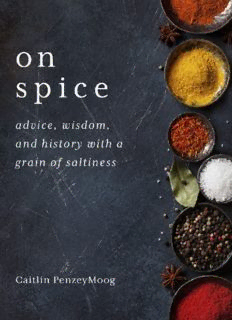
On Spice: Advice, Wisdom, and History with a Grain of Saltiness PDF
Preview On Spice: Advice, Wisdom, and History with a Grain of Saltiness
For Grandma, who is salt, and Grandpa, who is pepper. Contents Preface Salt Saffron Vanilla Cinnamon & Cassia Nutmeg & Mace Cloves Juniper Ginger Cardamom Seeds, Part 1 Fennel, Aniseed, Star Anise, Caraway & Coriander Herbs: A Digression Basil, Bay Leaves, Chervil, Cilantro, Dill, Fenugreek, Lavender, Marjoram, Mint, Oregano, Parsley, Rosemary, Sage, Savory, Tarragon, Thyme Seeds, Part 2 Mustard, Cumin, Poppy & Sesame Za’atar Garlic, Onion, Shallot & Chives Turmeric Curry Paprika & Cayenne Chilis Pepper Afterword Appendix A: Spice Blends Appendix B: Recipes Appendix C: Beverages Bibliography Conversion Charts Index Preface Igrew up working for my family in our spice shops. There were occasional stints at my aunt’s store in downtown Milwaukee, and some summers in college spent at the Penzeys Spices warehouse. Mostly, I worked and learned at my grandparents’ small store in a suburb of Milwaukee, Wisconsin. It didn’t look like much from outside: a squat rectangle, a triangular roof (like a child’s drawing) with bricks painted red and cracked pavement forming a three-car parking lot. Once you opened the door, though, something remarkable happened. A blast of aroma hit, pungent and overwhelming, sweet and savory, a thousand smells commingling until they blended into the smell of the Spice House. My grandparents started that humble store in 1957, the same year they married. They nurtured it over decades, then their children took up the business, and eventually their grandchildren came to pass through its doors on their own journeys, sifting and stirring and smelling from the time they were so young they could hardly hold the scoops. The red brick faded and was repainted, the price of vanilla rose and fell and rose again, and us three grandkids who worked the store on weekends and over summer breaks grew up among family and spice. The wares on the shelves remained mostly the same: the vanilla beans tall and proud behind glass, saffron tucked safely into the corner, a hundred apothecary jars lining shelves in long, tidy rows. A giant-old fashioned register emitted its shrill ca-ching when the cash drawer sprung open. Behind the counter hid a back room, where the mess sprawled across worktables and the shelves were lined with yet more spices, in giant burlap bags and big plastic barrels. You needed a scoop bigger than your hand to shovel out the salt. Tiny tins from Spain, still smelling of the saffron they transported, shone in the light, while the noisy cinnamon grinder stood at the ready, dusty with cinnamon powder and bulky, several decades old but looking like something that sprung out of the Industrial Revolution. That’s all gone now: the cinnamon grinder and the burlap and the old-fashioned cash register. It’s been cleared out of the building, which may stand empty but is forever imbued with the smells of a thousand spices. I last worked there four years ago, just before I moved from Milwaukee to Chicago for a new and exciting career. The future was such a strong pull that I didn’t mark that occasion, the ending of my time at the Spice House. The morning was spent simply, drinking coffee with my grandma while we filled jars of cinnamon at the front counter, where the soft surface made it safer to tap them down. Tap tap tap, and the cinnamon would settle a centimeter lower in the jar as the air escaped with a soft phut, and we’d fill the newly created space with more cinnamon. This is the method my grandfather taught me. He said that spices had music in them, if you knew how to listen. He had died several years before, and I hadn’t marked the last time I spoke with him any more than I did that last time I closed up the store and locked the finicky old door behind me. Writing this book has, in many ways, been my attempt to get back to that place. Its potent spice smell was the most familiar in the world to me and my brother and sister, growing up amongst its wares. We’d crowd in the sugary warmth of the vanilla room to read books about mysticism, then go to the tiny kitchen where my grandfather would cook us pork chops with some mysterious combination of spices. Grandma would make coffee for herself and cassia tea for my grandfather. I never liked cassia tea then, but now I drink it almost every day. I’ve had to relearn much of what I’d forgotten: the origin of nutmeg and the different kinds of peppercorns, the nuanced difference between Turkish thyme and Mexican thyme, how to make dried mustard hot again. I grew up with spices, but they had been like air to me: I was surrounded and took it for granted. Informal lessons were applied over a thousand different customer interactions, wondering if we had a spice that could make broccoli taste good or whether grinding a nutmeg was really necessary for their holiday drink. Sometimes I
Description: